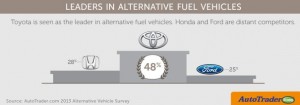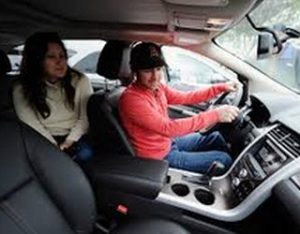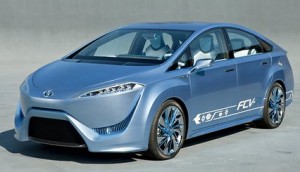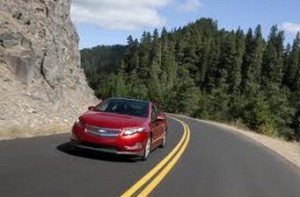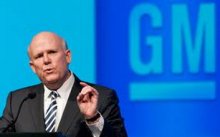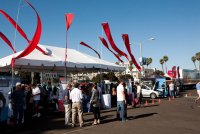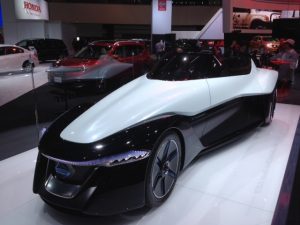 BMW’s award-winning electric vehicles and other automakers’ hydrogen-powered cars were the spotlights on Thursday at the LA Auto Show. Like all other car shows, new vehicle introductions and sporty concept cars were prevalent; USA Today’s Chris Woodyard thought the Lexus LF-C2 concept, Audi Prologue concept, and Infiniti Q80 Inspiration concept were memorable. The Infiniti Synaptiq race car took the People’s Choice Award in the 11th annual LA Auto Show Design Challenge. As for more conventional new vehicle rollouts, three of them stood out to observers: the 2015 Mazda CX-3, 2016 Cadillac ATS-V, and 2015 Honda CR-V.
BMW’s award-winning electric vehicles and other automakers’ hydrogen-powered cars were the spotlights on Thursday at the LA Auto Show. Like all other car shows, new vehicle introductions and sporty concept cars were prevalent; USA Today’s Chris Woodyard thought the Lexus LF-C2 concept, Audi Prologue concept, and Infiniti Q80 Inspiration concept were memorable. The Infiniti Synaptiq race car took the People’s Choice Award in the 11th annual LA Auto Show Design Challenge. As for more conventional new vehicle rollouts, three of them stood out to observers: the 2015 Mazda CX-3, 2016 Cadillac ATS-V, and 2015 Honda CR-V.
Here were some of the more interesting green vehicle developments:
- BMW’s new electric cars won accolades, with the BMW i3 taking the Green Car of the Year Award and, on Wednesday evening, the BMW i8 winning Autoblog’s 2014 Technology of the Year Award. The i8 had also won the Motor Press Guild’s 2014 Innovation Vehicle of the Year on Wednesday (along with the 2015 Ford F150). The lightweight carbon fiber and performance of the battery electric and plug-in hybrid systems impressed award judges. For Green Car of the Year, the i3 beat the Audi A3 TDI, the Chevrolet Impala bi-fuel CNG version, Honda Fit, and Volkswagen Golf.
- Similar to last year, hydrogen fuel cell vehicles were highly visible on display and during the Green and Advanced Technology Ride & Drive. As for concept vehicles, the Volkswagen Golf SportWagen HyMotion and the Audi A7 Sportback h-tron Quattro were popular during the ride and drive; and the Hyundai Tucson Fuel Cell and recently named Toyota Mirai were the production models to view during the show. Honda had unveiled a revised version of its FCV Concept in Japan a few days before the LA Auto Show; that car will be rolling out in 2016. For those of you interested in seeing a plug-in hybrid combined with an alternative fuel, the Audi h-tron can travel about 310 miles on hydrogen and about 31 miles on the battery.
- The Ford Fusion Energi and Toyota Highlander Hybrid won the first-ever Green Fleet Car and Truck of the Year awards during a luncheon meeting. Readers of the Bobit Business Media publications including Green Fleet voted on the winners. The Nissan Leaf and Honda Civic Natural Gas were runners up in the car category, while the Ram 1500 Eco Diesel and Ford Transit T150 Wagon FFV finished in the top three for the truck category. Bobit Business Media had collaborated with, and received technical assistance from, the National Renewable Energy Laboratory, Oak Ridge National Laboratory, and Argonne National Laboratory to determine the award nomination and selection criteria.
- Henrik Fisker has left the extended range Fisker Karma sports car behind and has gone back to another passion – designing muscle cars. Fisker and partner Galpin Auto Sports unveiled the Fisker Rocket, a 725-horsepower reworking of the 2015 Ford Mustang that Fisker called the “ultimate American muscle car.” It has several exterior modifications to give it a distinct look that Fisker has a lot of experience creating.
- I think the most visible car on display this year was the Nissan Blade Glider, a zero emission vehicle concept car. (See photo above.) Another good one was Volvo announcing its 2016 XC90 seven-passenger SUV during the show.
- Honda unveiled the Honda Developer Studio, an online portal and open innovation workspace in Silicon Valley. It’s part of Honda’s connected car strategy and coincides with its new Connect system for infotainment and navigation. It’s Android-based but it’s not part of Google’s Android Auto, Honda said.
- Through Hertz 24/7, the major car rental company’s carsharing division, Hertz was demonstrating its PIN-pad six-digit code system at the ride and drive. The idea behind it is that you can leave the car or truck in a parking lot and the next Hertz 24/7 user can open and start it from the door panel or from their mobile device. Drivers can use the NeverLost dashboard device to get directions anywhere they want to go. They’re testing out the system on pickup trucks with Lowes so that users without trucks can go by some large items that won’t fit into their cars and will have access to a pickup for a couple of hours.
- Team Fuel Saver won the Ford Car-Connected City App competition. That came out a September hackathon competition with 70 entrants that were narrowed down to 10 finalists from the developer community. The Team Fuel Saver shows all kinds of data on fuel consumption, fuel prices, and oil changes and other maintenance activities. The 10 finalists showed their apps during Connected Car Expo and the winner will be demonstrated at the CEI convention in January.
- David Cummins, senior VP and managing director at Xerox Services, talked about the urbanization trend in US cities and how it’s affecting the future of cars. Baby Boomers – about 50-to-70 years old, are showing more interest and appeal with driverless cars; as the generation ages and loses the ability to drive, the advanced technology is expected to gain support. Millennials in the 18-to-35 year old age range are showing a lot of interest in what he called “urban mobility networks” and their implications for getting through traffic congestion and reducing air pollution as more of them live and work in metro areas. The challenge for connected, autonomous vehicles will be building a platform between public and private providers. The cornerstone must be “open data,” and a flexible network that can meet new innovations, Cummins said.


